What is Computer Assisted Surgery?
Learn about what it means when your surgeon uses a computer to assist with your joint replacement. EspañolComputers have been assisting surgeons in the operating room since the 1980s. Today approximately 7% of all joint replacement surgeries are completed with the aid of computer navigation technology. Similar to the GPS in your car, these devices guide surgeons to precisely position the components of a hip or knee replacement. These tools can help surgeons decide what thickness of bone to remove and how to improve limb alignment. In theory, a well-balanced and properly aligned joint replacement should, like your new car tires, last longer if in acceptable alignment. The number of joint replacements done with this technology may grow over the next decade as it continues to improve.
Computer-assisted surgery (CAS) enables the surgeon to customize each joint replacement operation down to the degree and millimeter. The computer can make calculations to give the surgeon the immediate feedback. Multiple studies have shown that computer-assisted surgery may improve limb alignment and implant position; however, whether this affects how well you recover and function after surgery is open for debate. Current research has yet to prove a major advantage for surgeons using these new technologies. One recent study found no functional difference in people who had a CAS joint replacement compared to those who had surgery performed with manual instrumentation.
Computer Navigation
Computer-assisted surgery (CAS) enables the surgeon to customize each joint replacement operation down to the degree and millimeter. The computer can make calculations to give the surgeon the immediate feedback. Multiple studies have shown that computer-assisted surgery may improve limb alignment and implant position; however, whether this affects how well you recover and function after surgery is open for debate. Current research has yet to prove a major advantage for surgeons using these new technologies. One recent study found no functional difference in people who had a CAS joint replacement compared to those who had surgery performed with manual instrumentation.
During surgery, the surgeon collects data points to help the computer generate a virtual model of your hip or knee joint. Some navigation systems require a CT or MRI to be uploaded to the computer before surgery (image-guided navigation) while others do not (image-free navigation). The surgeon can make changes to the plan during surgery to ensure the proper positioning of the implants.
Robotic-Assisted Surgery
Robotic-assisted surgery represents a special category of CAS where a cutting tool is housed in a handpiece or robotic arm. After collecting data points and uploading them to the computer, a patient-specific three-dimensional model is generated which allows the surgeon to adjust the bone resections (the amount of bone removed) to best fit the implants. Next, the robotic tool is used to carefully prepare the bone and execute the surgical plan – always under the surgeon’s control. Regardless of the technique, once the bone is prepared, “off-the-shelf” implants are utilized to complete the surgery.
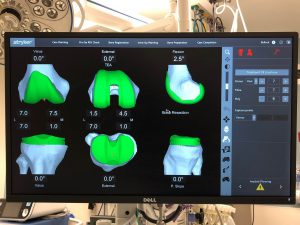
Computer software helps plan the position of the implants to determine joint alignment.
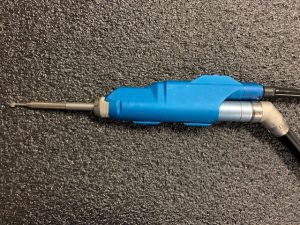
Hand-held cutting burr used by the surgeon to remove a certain thickness of bone based on the computerized plan.
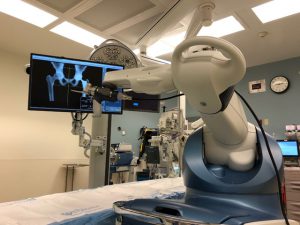
A robotic arm holds the sawblade in a precise position to make an accurate bone cut. The surgeon manually controls the blade based on the computerized plan.
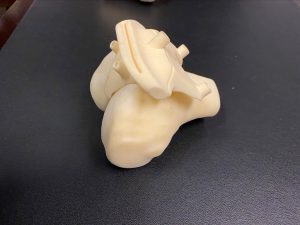
A PSI guide made to fit precisely over the end of the thigh bone.
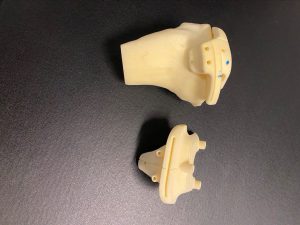
Another example of a PSI guide made to fit over the top of the shin bone.
Patient Specific Instrumentation
Another category of tool developed over the past several years is patient-specific instrumentation (PSI). This technology allows the surgeon to make specific bone cuts to match the “off-the-shelf” implants. It does not allow for “custom” implants. After obtaining a pre-operative CT or MRI scan, the images are then used to develop a preliminary plan of where to make the bone cuts to balance and align the arthritic joint. This plan is then sent to the surgeon to review and make edits prior to surgery. Once approved by the surgeon, a patient-specific cutting jig that is 3D printed and fits over the end of the thigh bone and top of the shin bone during surgery. These cutting blocks are then sterilized and sent to the surgeon to use during surgery.
PSI is a tool that may allow the surgeon to precisely restore a patient’s limb alignment. Studies have shown improved alignment with PSI but no long-term benefit for patients compared to traditional techniques.
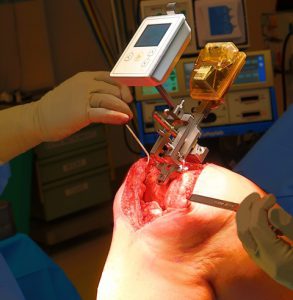
A pressure sensing paddle placed in the joint during surgery.
Other Technologies
Several hand-held devices can also be used by joint replacement surgeons. A pressure-sensing paddle can be placed between the bones during surgery to help the surgeon determine proper positioning of implants. Another option is a hand-held navigation unit with a miniature gyroscope (like your smartphone) that can be used to help determine limb alignment. Again, these other hand-held technologies have been shown to help improve alignment of the leg and position of the implants but so far there has been no proven long-term benefit for patients.
What does this mean for my surgery?
Multiple studies have demonstrated that CAS can improve implant positioning to restore leg alignment. This can provide a significant benefit in unique cases such as prior trauma (bone fractures or injuries) with orthopaedic implants or severe deformity. Some studies describe improved x-rays after surgery, but CAS has not yet translated to having better joint function or longer lifespan of the implants over the long-term.
We do know that CAS has been shown to have little effect on length of hospital stay and pain levels after surgery. It is still too early to say if CAS should be used for everyone. Currently, CAS is reserved for certain patients or if the surgeon is familiar with the technology and find a benefit for his or her patients. Just like a new tool, surgeons adopting these new technologies must properly learn how to use the computerized instruments and how to troubleshoot if the technology fails during surgery.
Utilizing these technologies comes with a price. Some of these technologies can significantly increase the price tag of your surgery as well as increase the time it takes to complete the procedure. Future research will help determine if the cost is worth the benefit.
Historically, the majority of patients have been satisfied with their joint replacements using conventional methods. Technology is another tool that your surgeon may use to perform your surgery. CAS can improve the accuracy of your surgery, but research is still lacking regarding the long-term benefits on function and longevity of your implant.
The surgeon needs to have a firm understanding of joint replacement surgery as the computer does not replace the experience acquired over years of practice. It is important for you to have a discussion with your surgeon before surgery if the use of this technology is important to you.
References
Wasterlain AS, Buza JA 3rd, Thakkar SC, Schwarzkopf R, Vigdorchik J. Navigation and Robotics in Total Hip Arthroplasty. JBJS Rev. 2017 Mar 14;5(3). pii: 01874474-201703000-00005. doi: 10.2106/JBJS.RVW.16.00046.
Buza JA 3rd, Wasterlain AS, Thakkar SC, Meere P, Vigdorchik J. Navigation and Robotics in Knee Arthroplasty. JBJS Rev. 2017 Feb 28;5(2). pii: 01874474-201702000-00001. doi: 10.2106/JBJS.RVW.16.00047.
Perets I, Walsh JP, Close MR, Mu BH, Yuen LC, Domb BG. Robot-assisted total hip arthroplasty: Clinical outcomes and complication rate. Int J Med Robot. 2018 Aug;14(4):e1912. doi: 10.1002/rcs.1912. Epub 2018 May 15.
Karunaratne S, Duan M, Pappas E, Fritsch B, Boyle R, Gupta S, Stalley P, Horsley M, Steffens D. The effectiveness of robotic hip and knee arthroplasty on patient-reported outcomes: A systematic review and meta-analysis. Int Orthop. 2019 Jun;43(6):1283-1295. doi: 10.1007/s00264-018-4140-3. Epub 2018 Sep 15.
Han PF, Chen CL, Zhang ZL, Han YC, Wei L, Li PC, Wei XC. Robotics–assisted versus conventional manual approaches for total hip arthroplasty: A systematic review and meta-analysis of comparative studies. Int J Med Robot. 2019 Jun;15(3):e1990. doi: 10.1002/rcs.1990. Epub 2019 Mar 4.
Antonios JK, Korber S, Sivasundaram L, Mayfield C, Kang HP, Oakes DA, Heckmann ND. Trends in computer navigation and robotic assistance for total knee arthroplasty in the United States: an analysis of patient and hospital factors. Arthroplast Today. 2019 Mar 12;5(1):88-95. doi: 10.1016/j.artd.2019.01.002. eCollection 2019 Mar.
Kim YH, Yoon SH, Park JW. Does Robotic–assisted TKA Result in Better Outcome Scores or Long-Term Survivorship Than Conventional TKA? A Randomized, Controlled Trial. Clin Orthop Relat Res. 2019 Jul 31. doi: 10.1097/CORR.0000000000000916
Taufiq R. Panjwani, Arun Mullaji, Karan Doshi, Harshad Thakur. Comparison of Functional Outcomes of Computer-Assisted vs Conventional Total Knee Arthroplasty: A Systematic Review and Meta-Analysis of High-Quality, Prospective Studies. J Arthroplasty. 2018 Dec 1.
This article has been written by Matthew W. Bullock, DO in collaboration with the AAHKS Patient and Public Relations Committee and peer reviewed by the AAHKS Evidence Based Medicine Committee.
Links to these pages or content used from the articles must be given proper citation to the American Association of Hip and Knee Surgeons.


